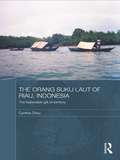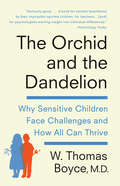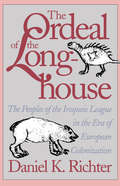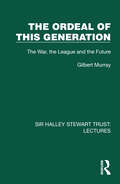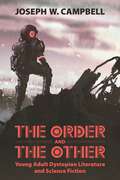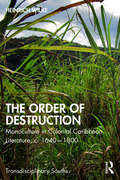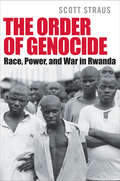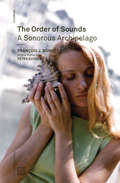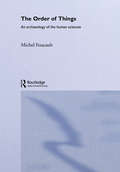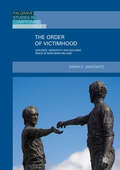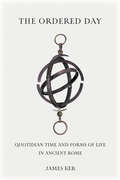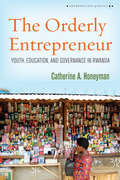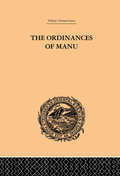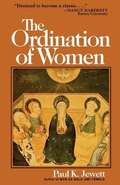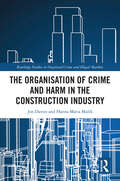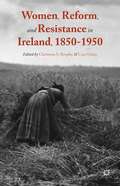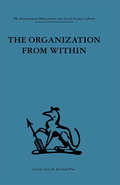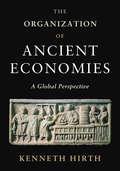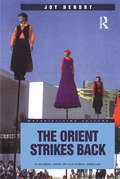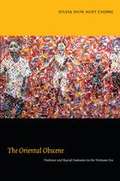- Table View
- List View
The Orang Suku Laut of Riau, Indonesia: The inalienable gift of territory (The Modern Anthropology of Southeast Asia)
by Cynthia ChouLand reform has been an indisputable part of Indonesian revolution. The consequent execution of development programmes for nation-building have provoked intense hostility over territorial rights. Global market forces in Indonesia have seen increasing flows of transnational investments, technology and resources that have resulted in great demand on sea and land spaces. In this momentum of change, several aspects of rural culture including indigenous populations, like the Orang Suku Laut (people of the sea) of Riau have been deemed by the state architects of development programmes to hinder progress. For generations, the sea and coastal places have been the life and living spaces of the Orang Suku Laut and they claim ownership to these territories based upon customary laws. The developmental pressure thus generated has led to intense struggles over territorial rights. It has also raised issues concerning the social assimilation of indigenous peoples as citizens, religious conversion and cultural identity. Cynthia Chou discusses how Indonesian nation-building development programmes have generated intense struggles over issues pertaining to territorial rights, social assimilation of indigenous peoples as citizens, religious conversion and cultural identity This book is a stimulating read for those interested in Social and Cultural Anthropology, Development Studies and Southeast Asian Studies.
The Orchid and the Dandelion: Why Some Children Struggle and How All Can Thrive
by W. Thomas BoyceFrom one of the world's foremost researchers and pioneers of pediatric health--a book that offers hope and a pathway to success for parents, teachers, psychologists, pyschiatrists, and child development experts coping with "difficult" children. A book that fully explores the author's revolutionary discovery about childhood development, parenting, and the key to helping all children find happiness and success.In The Orchid and the Dandelion, Dr. W. Thomas Boyce writes of the "dandelion" child (hardy, resilient, healthy), able to survive and flourish under most circumstances, and the "orchid" child (sensitive, susceptible, fragile), who, given the right support, can thrive as much as, if not more than, other children. For the past four decades Boyce has been working with troubled children. The Orchid and the Dandelion offers help to those who have lost their confidence in the promise of a child gone seriously adrift--into drug abuse, delinquency, depression, or destructive friendships, the dark territory of psychological trouble, school failure, or criminality.Boyce's breakthrough research reveals how genetic makeup and environment shape behavior. Rather than seeing this "risk" gene as a liability, through his daring research, Boyce has recast the way we think of human frailty and shows that while variant genes can create problems (susceptibility to depression, anxiety, attention deficit hyperactivity disorder, and antisocial, sociopathic, or violent behaviors), they can also, in the right setting and with the right nurturing, produce children who not only do better than before but far exceed their peers. He describes what it is to be an "orchid" child, to live a life far more intense, painful, vivid, and variable than that of a dandelion. For orchid children, the world is often a frightening and overwhelming place. He makes clear that orchids are not failed dandelions and shows people how to embrace the unique gifts, abilities, and strengths of orchid children and how to create and environment at home and work that will allow them to flourish.Boyce writes, as well, of dandelions: how vital they are to what George Eliot describes as "the growing good of the world," even in the midst of their own struggles and life challenges. He writes of his own family, particularly of his sister, the inspiration for his work, an orchid child overcome by the family's tragedies and sadnesses to which the author, as a dandelion child, was impervious.And we come to understand that beneath the servicable categories of "orchid" and "dandelion" lies the truer reality of a continuum, a spectrum of sensitivities to the world, along which we all have a place.
The Orchid and the Dandelion: Why Some Children Struggle and How All Can Thrive
by W. Thomas BoyceFrom one of the world's foremost researchers and pioneers of pediatric health--a book that offers hope and a pathway to success for parents, teachers, psychologists, pyschiatrists, and child development experts coping with "difficult" children. A book that fully explores the author's revolutionary discovery about childhood development, parenting, and the key to helping all children find happiness and success.In The Orchid and the Dandelion, Dr. W. Thomas Boyce writes of the "dandelion" child (hardy, resilient, healthy), able to survive and flourish under most circumstances, and the "orchid" child (sensitive, susceptible, fragile), who, given the right support, can thrive as much as, if not more than, other children. For the past four decades Boyce has been working with troubled children. The Orchid and the Dandelion offers help to those who have lost their confidence in the promise of a child gone seriously adrift--into drug abuse, delinquency, depression, or destructive friendships, the dark territory of psychological trouble, school failure, or criminality.Boyce's breakthrough research reveals how genetic makeup and environment shape behavior. Rather than seeing this "risk" gene as a liability, through his daring research, Boyce has recast the way we think of human frailty and shows that while variant genes can create problems (susceptibility to depression, anxiety, attention deficit hyperactivity disorder, and antisocial, sociopathic, or violent behaviors), they can also, in the right setting and with the right nurturing, produce children who not only do better than before but far exceed their peers. He describes what it is to be an "orchid" child, to live a life far more intense, painful, vivid, and variable than that of a dandelion. For orchid children, the world is often a frightening and overwhelming place. He makes clear that orchids are not failed dandelions and shows people how to embrace the unique gifts, abilities, and strengths of orchid children and how to create and environment at home and work that will allow them to flourish.Boyce writes, as well, of dandelions: how vital they are to what George Eliot describes as "the growing good of the world," even in the midst of their own struggles and life challenges. He writes of his own family, particularly of his sister, the inspiration for his work, an orchid child overcome by the family's tragedies and sadnesses to which the author, as a dandelion child, was impervious.And we come to understand that beneath the servicable categories of "orchid" and "dandelion" lies the truer reality of a continuum, a spectrum of sensitivities to the world, along which we all have a place.
The Ordeal of the Longhouse
by Daniel K. RichterRichter examines a wide range of primary documents to survey the responses of the peoples of the Iroquois League--the Mohawks, Oneidas, Onondagas, Cayugas, Senecas, and Tuscaroras--to the challenges of the European colonialization of North America. He demonstrates that by the early eighteenth century a series of creative adaptations in politics and diplomacy allowed the peoples of the Longhouse to preserve their cultural autonomy in a land now dominated by foreign powers.
The Ordeal of this Generation: The War, the League and the Future (Sir Halley Stewart Trust: Lectures)
by Gilbert MurrayOriginally published in 1929, profound changes, political, social, economic and intellectual, had taken place during the previous fifty years in the environment of civilized man, and it was still doubtful whether or not he would succeed in understanding them and adapting himself to meet them. That is the “ordeal” which forms the subject of these lectures, delivered in the autumn of 1928 under the auspices of the Sir Halley Stewart Trust. The trust was founded in 1924 for research towards the Christian ideal in all social life.This book is a re-issue originally published in 1929. The language used and views portrayed are a reflection of its era and no offence is meant by the Publishers to any reader by this re-publication.
The Order and the Other: Young Adult Dystopian Literature and Science Fiction (Children's Literature Association Series)
by Joseph W. CampbellIn the mid- to late 2000s, the United States witnessed a boom in dystopian novels and films intended for young audiences. At that time, many literary critics, journalists, and educators grouped dystopian literature together with science fiction, leading to possible misunderstandings of the unique history, aspects, and functions of science fiction and dystopian genres. Though texts within these two genres may share similar settings, plot devices, and characters, each genre’s value is different because they do distinctively different sociocritical work in relation to the culture that produces them. In The Order and the Other: Young Adult Dystopian Literature and Science Fiction, author Joseph W. Campbell distinguishes the two genres, explains the function of each, and outlines the different impact each has upon readers. Campbell analyzes such works as Lois Lowry’s The Giver and James Dashner’s The Maze Runner, placing dystopian works into the larger context of literary history. He asserts both dystopian literature and science fiction differently empower and manipulate readers, encouraging them to look critically at the way they are taught to encounter those who are different from them and how to recognize and work within or against the power structures around them. In doing so, Campbell demonstrates the necessity of both genres.
The Order of Destruction: Monoculture in Colonial Caribbean Literature, c. 1640-1800 (Transdisciplinary Souths)
by Heinrich WilkeThis book studies sugarcane monoculture, the dominant form of cultivation in the colonial Caribbean, in the later 1600s and 1700s up to the Haitian Revolution. Researching travel literature, plantation manuals, Georgic poetry, letters, and political proclamations, this book interprets texts by Richard Ligon, Henry Drax, James Grainger, Janet Schaw, and Toussaint Louverture.As the first extended investigation into its topic, this book reads colonial Caribbean monoculture as the conjunction of racial capitalism and agrarian capitalism in the tropics. Its eco-Marxist perspective highlights the dual exploitation of the soil and of enslaved agricultural producers under the plantation regime, thereby extending Marxist analysis to the early colonial Caribbean. By focusing on textual form (in literary and non-literary texts alike), this study discloses the bearing of monoculture on contemporary writers’ thoughts. In the process, it emphasizes the significance of a literary tradition that, despite its ideological importance, is frequently neglected in (postcolonial) literary studies and the environmental humanities.Located at a crossroads of disciplines and perspectives, this study will be of interest to literary/cultural critics and historians working in the early Americas and in Atlantic studies, to students and scholars of agriculture, colonialism, and (racial) capitalism, to Marxists and postcolonial critics, and to those working in the environmental humanities and in Global South studies.
The Order of Genocide
by Scott StrausThe Rwandan genocide has become a touchstone for debates about the causes of mass violence and the responsibilities of the international community. Yet a number of key questions about this tragedy remain unanswered: How did the violence spread from community to community and so rapidly engulf the nation? Why did individuals make decisions that led them to take up machetes against their neighbors? And what was the logic that drove the campaign of extermination? According to Scott Straus, a social scientist and former journalist in East Africa for several years (who received a Pulitzer Prize nomination for his reporting for the Houston Chronicle), many of the widely held beliefs about the causes and course of genocide in Rwanda are incomplete. They focus largely on the actions of the ruling elite or the inaction of the international community. Considerably less is known about how and why elite decisions became widespread exterminatory violence. Challenging the prevailing wisdom, Straus provides substantial new evidence about local patterns of violence, using original research-including the most comprehensive surveys yet undertaken among convicted perpetrators-to assess competing theories about the causes and dynamics of the genocide. Current interpretations stress three main causes for the genocide: ethnic identity, ideology, and mass-media indoctrination (in particular the influence of hate radio). Straus's research does not deny the importance of ethnicity, but he finds that it operated more as a background condition. Instead, Straus emphasizes fear and intra-ethnic intimidation as the primary drivers of the violence. A defensive civil war and the assassination of a president created a feeling of acute insecurity. Rwanda's unusually effective state was also central, as was the country's geography and population density, which limited the number of exit options for both victims and perpetrators. In conclusion, Straus steps back from the particulars of the Rwandan genocide to offer a new, dynamic model for understanding other instances of genocide in recent history-the Holocaust, Armenia, Cambodia, the Balkans-and assessing the future likelihood of such events.
The Order of Sounds: A Sonorous Archipelago
by Francois J. BonnetThis study of the subtlety, complexity, and variety of modes of hearing maps out a “sonorous archipelago”—a heterogeneous set of shifting sonic territories shaped by the vicissitudes of desire and discourse. Profoundly intimate yet immediately giving onto distant spaces, both an “organ of fear” and an echo chamber of anticipated pleasures, an uncontrollable flow subject to unconscious selection and augmentation, the subtlety, complexity, and variety of modes of hearing has meant that sound has rarely received the same philosophical attention as the visual. In The Order of Sounds, François J. Bonnet makes a compelling case for the irreducible heterogeneity of “sound,” navigating between the physical models constructed by psychophysics and refined through recording technologies, and the synthetic production of what is heard. From primitive vigilance and sonic mythologies to digital sampling and sound installations, he examines the ways in which we make sound speak to us, in an analysis of listening as a plurivocal phenomenon drawing on Foucault, Deleuze and Guattari, Barthes, Nancy, Adorno, and de Certeau, and experimental pioneers such as Tesla, Bell, and Raudive. Stringent critiques of the “soundscape” and “reduced listening” demonstrate that univocal ontologies of sound are always partial and politicized; for listening is always a selective fetishism, a hallucination of sound filtered by desire and convention, territorialized by discourse and its authorities. Bonnet proposes neither a disciplined listening that targets sound “itself,” nor an “ocean of sound” in which we might lose ourselves, but instead maps out a sonorous archipelago—a heterogeneous set of shifting sonic territories shaped and aggregated by the vicissitudes of desire and discourse.
The Order of Things: An Archaeology Of The Human Sciences (Routledge Classics)
by Michel FoucaultWhen one defines "order" as a sorting of priorities, it becomes beautifully clear as to what Foucault is doing here. With virtuoso showmanship, he weaves an intensely complex history of thought. He dips into literature, art, economics and even biology in The Order of Things, possibly one of the most significant, yet most overlooked, works of the twentieth century. Eclipsed by his later work on power and discourse, nonetheless it was The Order of Things that established Foucault's reputation as an intellectual giant. Pirouetting around the outer edge of language, Foucault unsettles the surface of literary writing. In describing the limitations of our usual taxonomies, he opens the door onto a whole new system of thought, one ripe with what he calls "exotic charm". Intellectual pyrotechnics from the master of critical thinking, this book is crucial reading for those who wish to gain insight into that odd beast called Postmodernism, and a must for any fan of Foucault.
The Order of Victimhood: Violence, Hierarchy and Building Peace in Northern Ireland (Palgrave Studies in Compromise after Conflict)
by Sarah E. JankowitzThis book explores how the construction and contestation of victims in societies emerging from conflict impact processes of peacebuilding. It locates its inquiry in Northern Ireland where highly politicized, unresolved narratives of violence and a so-called ‘hierarchy of victims’ illuminate inherent paradoxes of victimhood in intergroup conflict. The author critiques how mechanisms designed to address the legacy of conflict often reify exclusive ‘victim’ and ‘perpetrator’ identities and obscure complex harm. Adopting an interdisciplinary lens, the book examines how the image of the ideal victim interacts with intergroup processes in a polarizing and intractable victim-perpetrator paradigm. The analysis of these issues in Northern Ireland suggests that exclusive policies and mechanisms reinforce rather than repair societal divisions, and that inclusive, complex approaches to victimhood are necessary to build sustainable peace. This book will be of particular interest to scholars of peace studies, transitional justice and criminology.
The Ordered Day: Quotidian Time and Forms of Life in Ancient Rome (Cultural Histories of the Ancient World)
by James KerTraces how the day has served as a key organizing concept in Roman culture—and beyond.How did ancient Romans keep track of time? What constituted a day in ancient Rome was not the same twenty-four hours we know today. In The Ordered Day, James Ker traces how the day served as a key organizing concept, both in antiquity and in modern receptions of ancient Rome. Romans used the story of how the day emerged as a unit of sociocultural time to give order to their own civic and imperial history. Ancient literary descriptions of people's daily routines articulated distinctive forms of life within the social order. And in the imperial period and beyond, outsiders—such as early Christians in their monastic rules and modern antiquarians in books on daily life—ordered their knowledge of Roman life through reworking the day as a heuristic framework.Scholarly interest in Roman time has recently moved from the larger unit of the year and calendar to smaller units of time, especially in the study of sundials and other timekeeping technologies of the ancient Mediterranean. Through extensive analysis of ancient literary texts and material culture as well as modern daily life handbooks, Ker demonstrates the privileged role that "small time" played, and continues to play, in Roman literary and cultural history. Ker argues that the ordering of the day provided the basis for the organizing of history, society, and modern knowledge about ancient Rome. For readers curious about daily life in ancient Rome as well as for students and scholars of Roman history and Latin literature, The Ordered Day provides an accessible and fascinating account of the makings of the Roman day and its relationship to modern time structures.
The Orderly Entrepreneur: Youth, Education, and Governance in Rwanda
by Catherine HoneymanThe first generation of children born after Rwanda's 1994 genocide is just now reaching maturity, setting aside their school uniforms to take up adult roles in Rwandan society and the economy. At the same time, Rwanda's post-war government has begun to shrug off international aid as it pursues an increasingly independent path of business-friendly yet strongly state-regulated social and economic development. The Orderly Entrepreneur tells the story of a new Rwanda now at the vanguard among developing countries, emulating the policies of Singapore, Korea, and China, and devoutly committed to entrepreneurship as a beacon for 21st century economic growth. Drawing on ethnographic research with nearly 500 participants, The Orderly Entrepreneur investigates the impact and reception of the Rwandan government's multiyear entrepreneurship curriculum, first implemented in 2007 as required learning in all secondary schools. As Honeyman shows, "entrepreneurship" is more than a benign buzzword or hopeful panacea for economic development, but a complex ideal with unique meanings across Rwandan society. She reveals how curriculum developers, teachers, and students all brought their own interpretations and influence to the new entrepreneurship curriculum, exposing how even a carefully engineered project of social transformation can be full of indeterminacies and surprising twists every step of the way.
The Orders of the Dreamed: George Nelson on Cree and Northern Ojibwa Religion and Myth, 1823
by Jennifer S.H. Brown Robert BrightmanThe introduction by Brown and Brightman describes Nelson's career in the fur trade and explains the influences affecting his perception and understanding of Native religions. They also provide a comparative summary of Subarctic Algonquian religion, with emphasis on the beliefs and practices described by Nelson. Stan Cuthand, a Cree Anglican minister, author, and language instructor, who lived in Lac la Ronge in the 1940s, adds a commentary relating Nelson's writing to his own knowledge of Cree religion in Saskatchewan. Emma LaRoque, an author and instructor in Native Studies, presents a Native scholar's perspective on the ethics of publishing historical documents.
The Ordinances of Manu: Translated from the Sanskrit
by Arthur Coke BurnellFirst Published in 2000. Routledge is an imprint of Taylor & Francis, an informa company.
The Ordination of Women: An Essay on the Office of Christian Ministry
by Paul K. JewettDr. Jewett wrote "My thesis is that the woman, as the man's equal, should share with him in all aspects of the church's life and mission. Specifically, this means that she should have full access to the privileges and responsibilities of the Christian ministry. I review the traditional grounds for excluding women from ordination to this office, beginning with the argument from the nature of woman, proceeding to that of the nature of the ministerial office, and concluding with that of the nature of God himself. This last argument--wherein it is assumed that the masculinity of God entails a male order of ministry--occupies the largest place in the discussion. . . . Having reviewed these several arguments, and having rejected them as resting on an inadequate understanding of biblical revelation, I then raise the question of what should be done in order that the Christian woman may enter into her full inheritance in the church as a minister of Jesus Christ. The suggestions I make bear particularly on matters of graduate education as it has traditionally been offered in the theological seminary. . . . I do not, in this essay, deal in any detailed way with the Pauline injunction to silence imposed upon women in church nor with the limitation placed upon their teaching in the Pastoral Epistles, since these matters are part of the larger question of the hierarchy of the sexes, a question which I discuss elsewhere. I do, however, in several addenda of varying length, touch on certain matters related to the discussion: the difference between the priestly and the prophetic offices; the effort to understand the Holy Spirit as female; the question of deaconesses in the New Testament; and the meaning of motherhood. In the final section (Epilogue) I explore the problem of sexist language, focusing especially on the question of how such language may be changed in the hymnal and the Bible. The suggestions made (often tentative in nature) and the conclusions reached are an effort to advance the problem a little way toward a solution."
The Organ Thieves: The Shocking Story of the First Heart Transplant in the Segregated South
by Chip JonesThe Immortal Life of Henrietta Lacks meets Get Out in this landmark investigation of racial inequality at the core of the heart transplant race. <P><P> In 1968, Bruce Tucker, a black man, went into Virginia’s top research hospital with a head injury, only to have his heart taken out of his body and put into the chest of a white businessman. Now, in The Organ Thieves, Pulitzer Prize–nominated journalist Chip Jones exposes the horrifying inequality surrounding Tucker’s death and how he was used as a human guinea pig without his family&’s permission or knowledge. <P><P>The circumstances surrounding his death reflect the long legacy of mistreating African Americans that began more than a century before with cadaver harvesting and worse. It culminated in efforts to win the heart transplant race in the late 1960s. Featuring years of research and fresh reporting, The Organ Thieves is a story that resonates now more than ever, when issues of race and healthcare are the stuff of headlines and horror stories.
The Organisation of Crime and Harm in the Construction Industry (Routledge Studies in Organised Crime)
by Jon Davies Hanna MalikDrawing on empirical work and secondary analysis from the UK and Finnish construction industries, this book contributes a deep-rooted analysis of construction industry harms that originate from corporate-industrialstate processes.The UK context arguably represents a classic ‘neoliberal’ system categorised by privatisation of services and minimal regulation, whereas Finland broadly provides a ‘social democratic’ alternative with its relatively strong national regulation and public sector oversight of industry. These concepts interlink strongly with the notion of state-corporate crime, since this perspective shifts attention away from individualistic explanations for crime and harm towards symbiosis between states and corporations. This book argues that existing explanations based on organised crime and individual ‘rogues’ are insufficient to account for the wider range and subtlety of harms that occur in construction, and therefore offers a unique perspective into organisational, industry, and state dynamics in this sector.An accessible and compelling read, this book will appeal to students and scholars of criminology, sociology, organized crime, and those interested in harms in the construction industry.
The Organisational Dynamics of University Reform in Japan: International Inside Out (Nissan Institute/Routledge Japanese Studies)
by Jeremy BreadenFor several decades internationalisation has been a cornerstone of both Japanese government higher education policy and approaches to reform at an institutional level, but Japan has still not managed to lose its reputation as a somewhat reclusive member of the global academic community. Consensus on the potential of internationalisation to reinvigorate Japanese higher education is matched by the depth of recognition that universities have, to date, failed to internationalise successfully. This book offers a new approach to Japan’s internationalisation conundrum by proceeding from the ‘inside out’. It presents an extended case study one university organisation that has been changed through its adoption of a radical program of internationalisation. Through this case study Jeremy Breaden identifies patterns by which internationalisation is situated in administrative discourse and individual action, and determines how these patterns in turn shape organisational practice. The result is a multi-dimensional narrative of organisational change that advances our understanding of both the dynamics of university reform and the concept of internationalisation, one of the most durable yet contentious themes in the study of contemporary Japanese society. With detailed analysis and an in-depth case study, this book will be of interest to students and scholars of Japanese studies, sociology and anthropology. It will also prove valuable to professionals and policy makers working in higher education, both in Japan and around the world.
The Organization Ecology of Interest Communities: Assessment and Agenda (Interest Groups, Advocacy and Democracy Series)
by Darren Halpin Virginia Gray David LoweryThis volume summarizes the origins and development of the organization ecology approach to the study of interest representation and lobbying, and outlines an agenda for future research. Multiple authors from different countries and from different perspectives contribute their analysis of this research program.
The Organization from Within: A comparative study of social institutions based on a sociotherapeutic approach
by Cyril SoferTavistock Press was established as a co-operative venture between the Tavistock Institute and Routledge & Kegan Paul (RKP) in the 1950s to produce a series of major contributions across the social sciences. This volume is part of a 2001 reissue of a selection of those important works which have since gone out of print, or are difficult to locate. Published by Routledge, 112 volumes in total are being brought together under the name The International Behavioural and Social Sciences Library: Classics from the Tavistock Press. Reproduced here in facsimile, this volume was originally published in 1961 and is available individually. The collection is also available in a number of themed mini-sets of between 5 and 13 volumes, or as a complete collection.
The Organization of Ancient Economies: A Global Perspective
by Kenneth HirthIn this book, Kenneth Hirth provides a comparative view of the organization of ancient and premodern society and economy. Hirth establishes that humans adapted to their environments, not as individuals but in the social groups where they lived and worked out the details of their livelihoods. He explores the variation in economic organization used by simple and complex societies to procure, produce, and distribute resources required by both individual households and the social and political institutions that they supported. Drawing on a wealth of archaeological, historic, and ethnographic information, he develops and applies an analytical framework for studying ancient societies that range from the hunting and gathering groups of native North America, to the large state societies of both the New and Old Worlds. Hirth demonstrates that despite differences in transportation and communication technologies, the economic organization of ancient and modern societies are not as different as we sometimes think.
The Organized Child: An Effective Program to Maximize Your Kid's Potential--in School and in Life
by Richard Gallagher Elana G. Spira Jennifer L. RosenblattAre you sick of nagging your child to write down homework assignments? Is his or her backpack a black hole that eats up papers, books, and gym clothes? Organizational skills problems aren't just frustrating--they get in the way of school success and wreak havoc at home. Fortunately, help is at hand. This unique resource stands out from other books because it is based on a scientifically tested program that works. Learn how you can teach your 7- to 13-year-old specific skills to: *Organize school materials and toys. *Track assignments. *Improve time management and planning. *Overcome brain "Glitches"--mischievous creatures that trip kids up. *Create and follow effective routines. Concrete examples, tips for strategically using praise and rewards, and practical tools (you can download and print additional copies as needed) help you implement each step of the program. Maximizing your kid's potential starts now--here's how. Mental health professionals, see also the related intervention manual from Gallagher et al., Organizational Skills Training for Children with ADHD: An Empirically Supported Treatment.
The Orient Strikes Back: A Global View of Cultural Display (Materializing Culture)
by Joy HendryAt the turn of the 20th Century, Japanese ‘villages' and their exotic occupants delighted and mystified visitors to the Great Exhibitions and Worlds' Fairs . At the beginning of the 21st Century, Japanese tourists have reversed the gaze and now may visit a range of European ‘countries', as well as several other cultural worlds, without ever leaving the shores of Japan. This book suggests that these and other exciting Asian theme parks pose a challenge to Western notions of leisure, education, and entertainment. Is this a case of reverse orientalism? Or is it simply a commercial follow-up on the success of Tokyo Disneyland? Is it an appropriation by one rich nation of a whole world of cultural delights from the countries that have influenced its twentieth-century success? Can the parks be seen as political statements about the heritage on which Japan now draws so freely? Or are they new forms of ethnographic museum? Examining Japanese parks in the context of a variety of historical examples of cultural display in Europe, the U.S. and Australia, as well as other Asian examples, the author calls into question the too easy adoption of postmodern theory as an ethnocentrically Western phenomenon and clearly shows that Japan has given theme parks an entirely new mode of interpretation.
The Oriental Obscene: Violence and Racial Fantasies in the Vietnam Era
by Sylvia Shin ChongThe Oriental Obscene is a sophisticated analysis of Americans' reactions to visual representations of the Vietnam War, such as the photograph of the "napalm girl," news footage of the Tet Offensive, and feature films from The Deer Hunter to Rambo: First Blood Part II. Sylvia Shin Huey Chong combines psychoanalytic and film theories with U.S. cultural history to explain what she terms the oriental obscene: racialized fantasies that Americans derived largely from images of Asians as the perpetrators or victims of extreme violence. Chong contends that these fantasies helped Americans to process the trauma of the Vietnam War, as well as the growth of the Asian American population after the Immigration and Nationality Act of 1965 and the postwar immigration of Southeast Asian refugees. The oriental obscene animated a wide range of political narratives, not only the movements for and against the war, but causes as diverse as the Black Power movement, law-and-order conservatism, second-wave feminism, and the nascent Asian American movement. During the Vietnam era, pictures of Asian bodies were used to make sense of race, violence, and America's identity at home and abroad.
